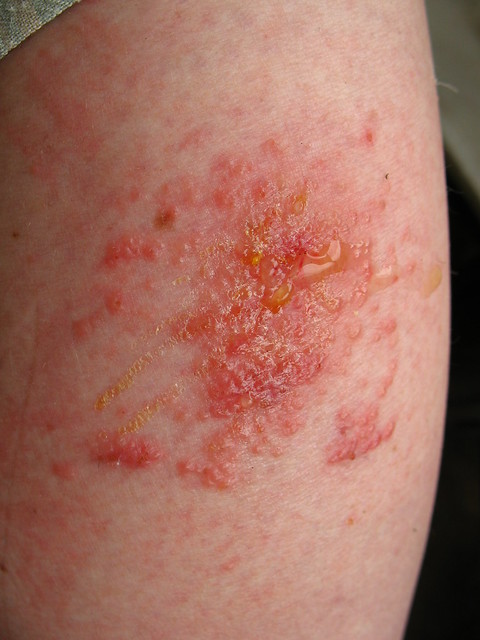

Photo by Mark Sardella
Poison ivy (and poison oak) contains the highly allergenic urushiol oil in all parts of the plant: its leaves, vines, roots, flowers, and berries, and can be spread either by contact or by breathing it in when burned.
It is a vine that loves sun or shade, growing along the edges of fields and forests, roadsides, fences, or
stone walls. It also loves to hide itself among innocent leaves, so don't just look for it in large patches.
It may grow as a single plant or as a bush and loves to twine itself around nearby objects. Here are a
few key identifying characteristics to tell if what you are seeing is poison ivy:
It is a vine that loves sun or shade, growing along the edges of fields and forests, roadsides, fences, or
stone walls. It also loves to hide itself among innocent leaves, so don't just look for it in large patches.
It may grow as a single plant or as a bush and loves to twine itself around nearby objects. Here are a
few key identifying characteristics to tell if what you are seeing is poison ivy:
- "Leaves of three: let them be!" is an old and accurate adage to follow. Not all three-leafed plants are poisonous, but poison ivy and poison oak are examples of plants that are, so it is safer to stay away. Poison ivy has three, broad leaves on the end of a long, smooth stem with one leaf growing off to each side and one straight up the middle. The middle leaf is usually larger than the other two and is typically attached by its own small stem piece; the two smaller side leaves are attached directly to the vine.
- The upper side of the leaf often has a waxy look (somewhat shiny) while the under side is lighter and fuzzier. Leaves are bright red in the spring or small the fall and bright green in the summer. The urushiol oil in the plant remains potent in all seasons. Even dead plants are dangerous.
- Leaves may be either smooth or have a softer, somewhat irregular jagged edge. If leaf tips are very sharp and regular, it is probably not poison ivy. The points of the leaf on poison ivy are more rounded.
- Berries are white or cream-colored. These remain throughout winter and spring, and yes, the plant should still not be touched in any season. Once the leaves have fallen, this may be one of the last physical features you can use to identify it.


Photo by Protoflux
A poison ivy rash may start out as a small itchy spot but soon grows to a larger, very, very itchy spot. Sores, blisters, hive, or swelling may appear. There may also be red streaks where the plant touched you. Generally, the first time you touch urushiol will take the longest for a rash to appear. With subsequent contacts, the rash appears more quickly. The rash is not contagious but may grow over several days as your exposed skin slowly reacts to the oil. Your rash may last 10 days, or 6 weeks depending on your sensitivity.


Photo by Vilseskogen
Some people may be lucky enough to escape with no allergic reaction but it should never be assumed you are one of them. Even if you've been immune in the past, this is no guarantee for the future because immunity frequently changes with time and exposure.
What do you do if you touch it?
- Wash with lots of cold water or alcohol as soon as you can (within 30 minutes if possible). Hot water opens the pores and may let more oil in, making your situation even worse. Scrub yourself with a heavy detergent or liquid soap created especially to eliminate oil. By acting as quickly as possible, you could help prevent more oil from soaking in.
- Jewelweed can be mashed and applied to help your rash.
- Heat helps calm itching. Once the oil has been washed off, you can then take a hot shower to help ease the itch. Wet compresses and baths may also aid in the discomfort.
- Calamine lotion or over-the-counter antihistamines may help ease symptoms.
- The urushiol oil spreads VERY EASILY. Be wary of spreading it from contaminated clothes or touching sensitive body parts (like your face) if it is on your hands. Any pets that have come in contact with the plant should be washed thoroughly to keep from passing the oil to their owners. Clothes and equipment must all be washed very well since the oil retains its potency for centuries.
- Most people break out in a rash within 24-48 hours. However, if you are extremely sensitive, swelling may start within 4-12 hours and symptoms may be severe. Watch for severe swelling and very large blisters. Quickly notify a doctor in such serious cases. There are prescription pills, ointments, and injections to help treat poison ivy rashes.
No comments:
Post a Comment